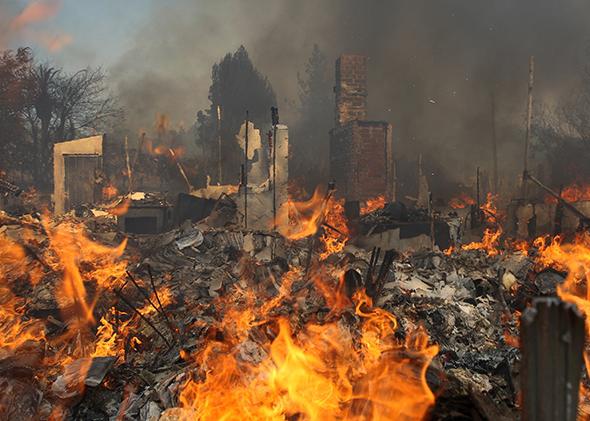A wildfire that began last week in central Washington has already destroyed an estimated 150 homes. At last count, it was threatening more than 500 other structures as firefighters continue to struggle to contain a blaze that has covered more than 300 square miles. A separate wildfire in southern Oregon destroyed 17 homes and 16 other structures, and forced the evacuation of more than 100 people last week. A third blaze currently raging in Idaho, one of about 20 sparked across the Boise National Forest by a lightning storm, has forced the evacuation of at least 60 homes.
None of these wildfires are particularly unique. Home-threatening blazes have become something of an annual ritual for many towns out West, one increasingly untethered to the calendar. In the past four decades, the length of the wildfire season has increased by more than two months. The average wildfire, meanwhile, now burns roughly twice as long and consumes twice as many acres than it did a decade ago. Since 2010, the number of structures destroyed by the fires has tripled, and firefighter fatalities have soared by a factor of four, according to the nonprofit research group Headwaters Economics. The Obama administration estimates it will spend $2.4 billion this year battling the blazes, nearly triple what was spent in an average year two decades ago. And the current spending levels are fast proving insufficient: This month the president sent Congress an emergency request for $615 million to help cover the government’s wildfire-fighting bill.
Already bad, things are only going to get worse. The Environmental Protection Agency estimates that wildfire activity could double in much of the Western half of the nation by 2050 as climate change leads to hotter and drier conditions across the country. While Congress has repeatedly shown no interest in combating (or, in some cases, even acknowledging) climate change, Western lawmakers on both sides of the aisle are finding it difficult to ignore the fires themselves. A bipartisan group of senators is currently rallying around a relatively straightforward proposal to help route more federal cash to both fighting the wildfires and preventing them.
The proposal, championed by Oregon Democrat Sen. Ron Wyden and Idaho Republican Sen. Mike Crapo, would make catastrophic wildfires eligible for assistance from a special federal disaster relief fund currently used to pay for recovery efforts from hurricanes and earthquakes. That tweak, supporters say, would allow the U.S. Forest Service and the Interior Department to stop rerouting cash from other crucial programs, including needed fire-prevention work such as removing dead vegetation and undergrowth that can act as tinder. A separate Republican proposal, backed by Sen. John McCain and others, meanwhile, would explicitly require the federal government to focus on thinning the underbrush in federal forests.
But while lawmakers might be looking at a bigger picture, they still aren’t looking as broadly as they should, wildfire experts warn. “It’s basically an account shuffle, one that does nothing to really address the magnitude of the problem,” says Ray Rasker, the executive director of Headwaters Economics, which held a private brainstorming session for 20 policy experts earlier this year to talk about the rising risks and costs of wildfires.
The most pressing issue, Rasker’s group concluded, is the slew of government policies currently in place that subtly encourage developers to build in wildfire-prone areas in the first place. Local governments are the ones deciding whether to develop the land, but it’s the federal and state governments that have to open their wallets when disaster strikes. As a result, local officials have little incentive to stop a high-risk development when they stand to reap the property tax rewards without bearing the full risks. “The consequences of those development decisions aren’t being felt by the people who are making them,” says Rasker.
If federal lawmakers took steps to shift the financial burden to local governments, the thinking goes, they’d be less likely to give carte blanche to developers. Lawmakers looking to offer carrots in addition to the stick, for instance, could tie the amount that each locality had to pay to how much effort it put into preventive measures in the first place. Impose tighter building codes in high-risk areas? Foot less of the federal firefighting bill if a wildfire does break out. Fail to take preventive action? Be prepared to pay on the back end. Lawmakers looking to take more direct action, meanwhile, could limit the mortgage interest deduction for any home in a particularly vulnerable region.
Intended or not, the status quo has resulted in a building boom in fire-prone areas. According to the International Code Council, 60 percent of new homes built in the United States between 1990 and 2008 were built on what is known as the “wildland urban interface”—basically private forested land in close proximity to public forested land, the type of landscape that’s particularly vulnerable to wildfires.
Such policies wouldn’t mean an end to building on those lands, Rasker says—it would just mean that communities would be enticed to make more deliberate and safer decisions on exactly where and how to build. That might not stop many wildfires from starting, but it would mean fewer homes in harm’s way when a wildfire does jump from public forest to private land. That, in turn, would mean more time, money, and options for firefighters trying to contain the massive blazes. But if Congress continues to fail to see the homes through the trees, the opposite will hold true: The government will be stuck paying more money to fight stronger fires that threaten more houses. “This is a trend,” Rasker says, “that’s going to get significantly worse if things don’t change.”
